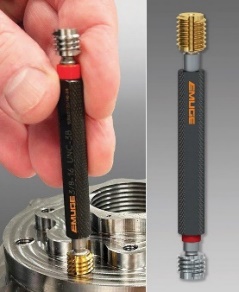TIN Coated Gages
TIN Coated Gages
TIN Coated Thread Gages have high dimensionally stable HSS construction with TIN coating that increases hardness and wear resistance, which extends lifespan and reduces the frequency of calibrations and replacements, saving time and cost. By minimizing friction, EMUGE TIN Coated Gages offer consistent measurements and precision thread sizing.

EMUGE-FRANKEN USA, a leading manufacturer of high-performance taps, thread mills, end mills, drills, gages and other rotary tools, announced it has expanded its precision thread gages line with new TIN Coated Gages featuring 3B class-of-fit, ensuring critical tolerance is met. The TIN coating also ensures extreme wear resistance for safety critical aerospace and medical applications, and in other demanding environments.
EMUGE TIN Coated Thread Gages have high dimensionally stable HSS construction with TIN coating that increases hardness and wear resistance, which extends lifespan and reduces the frequency of calibrations and replacements, saving time and cost. By minimizing friction, EMUGE TIN Coated Gages offer consistent measurements and precision thread sizing. Also, the TIN coating provides a protective barrier against abrasion and corrosion, even in hard or abrasive materials, and harsh environments. EMUGE TIN Coated Gages are available with a 3B class-of-fit in sizes #4 through 1" UNC/ UNF and metric sizes.
"We are pleased to expand our line of precision thread gages with new, highly durable TIN Coated Gages which offer improved accuracy when gaging a range of threading applications, such as challenging, precise aerospace and medical threaded holes," said Mr. Robert Adamiak, Sales Support Specialist, EMUGE-FRANKEN USA.





